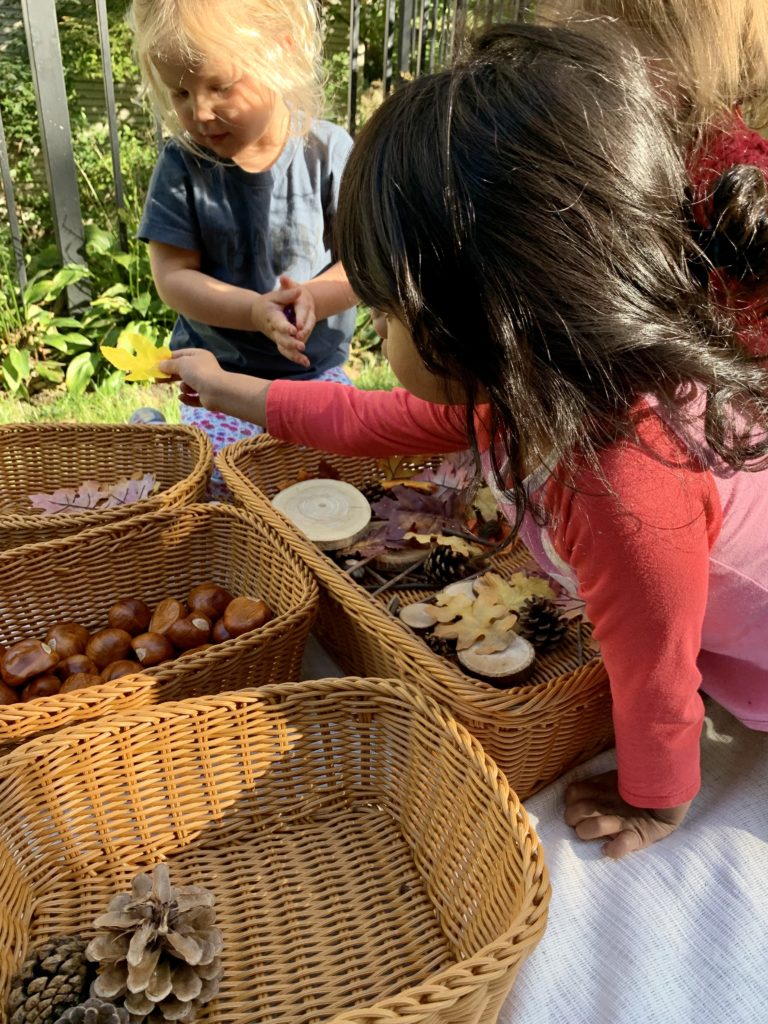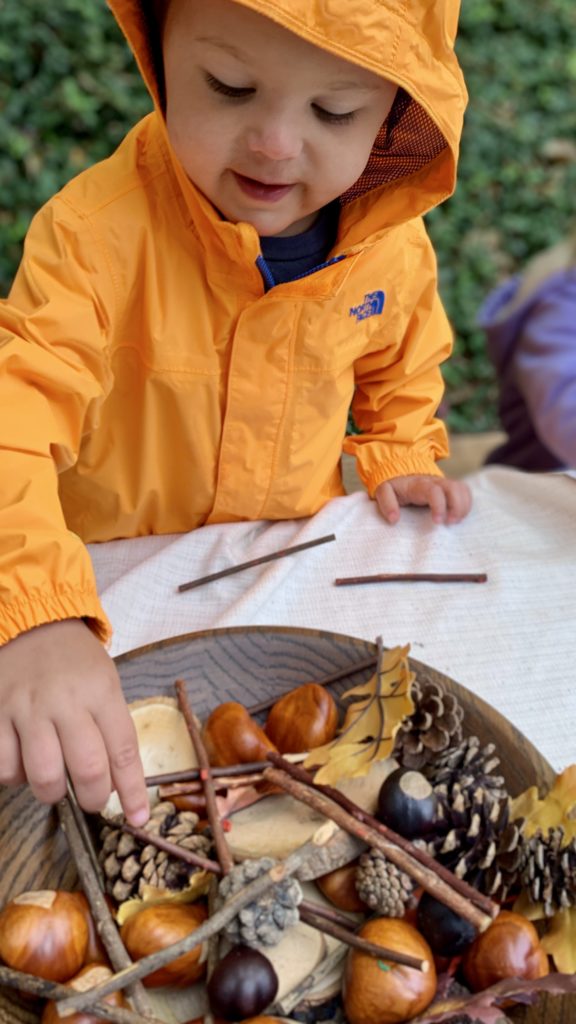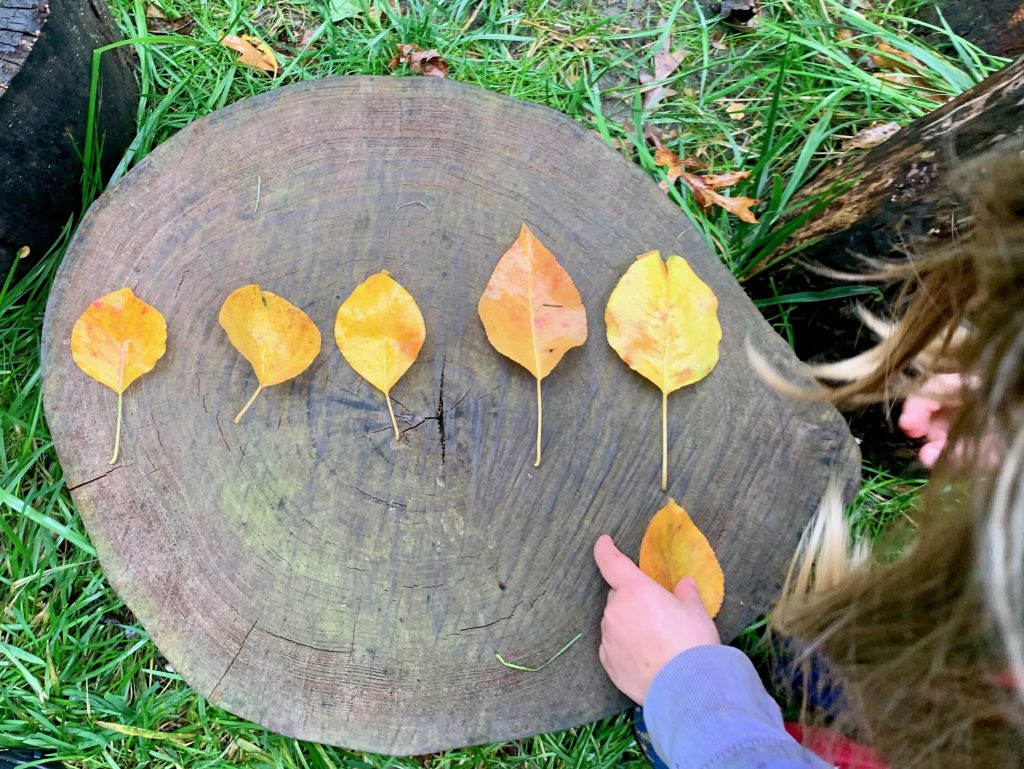What’s in YOUR Pocket? Collections in Early Childhood

Do you have collectors in your midst? Those young children who can turn a five-minute walk into a 15-minute treasure hunt? The children who fill their pockets with treasures and then load up your pockets with the overflow? I love these kids. They can wreak havoc with our daily schedules, but they help us slow down, take a breath, smile and find beauty in unexpected places. They also make me smile when I remind myself that these impromptu, child-led collecting and sorting expeditions are worth their weight in gold as we work with young children to build a strong foundation for later math learning.

We collect lots of natural loose parts like acorns and buckeyes, feathers and rocks. But we also collect colored gems, bottle caps, keys and other odd items. This, my friends, is the rock-solid, hands-on play that lays the foundation for number sense.
At all ages, children classify intuitively to make sense of a world that seems largely out of their control. By the time infants are two weeks old, they can distinguish between objects that they suck on and those they do not. By the age of two, toddlers form sets of similar objects. In preschool, children begin to sort objects into categories according to a given attribute.
If it attracts their attention and they touch it, that’s the moment the child-led learning begins! So grab a bag, a basket or a bucket, take a walk and see what sparks the imagination of the children in your life. A good pocket comes in handy on these expeditions!
Along the way, observe the collecting habits of your budding mathematicians. What captures their attention? What treasures do they deem worthy of pocketing? Does one of the younger treasure hunters in your group need guidance or mentoring?
During your expeditions—and other daily outings—keep your eyes out for heart rocks. It’s a great opportunity to build some early math skills, whether you’re waiting for a table to open up at a restaurant or killing time before an appointment. Hidden in those landscape rocks, there is sure to be a heart rock!

Children will naturally begin to sort their collected treasures into piles or “sets.” Separating will come very naturally as children sort acorns into one pile and bottle caps into another. They may group by colors, shape, texture or weight. They may also organize their objects in a line by size or other attributes.

As they sort the objects that they collect, children are building their analytical thinking skills, which are the lifeblood of mathematics. This is a great opportunity to introduce vocabulary words such as more and less. Young children have an inborn sense of more and less. They always know if someone has more than they do! Children can learn number sense simply by playing with their collections!

If the grouping of sets leads to counting, this is another great opportunity for young children to build foundational math skills. Regardless of how high a preschooler can rote count, a child’s sense of what those numbers actually mean develops gradually. We call this “understanding number sense,” and it requires relating numbers to actual quantities.
There are three core counting principles:
Counting Sequence
There is an ordered sequence of number names. Counting involves using the same sequence each time, starting with one. By using counting songs and moving each object as you give it a “name,” you can help children learn the counting sequence.
One-to-One Correspondence
One number from the counting sequence is assigned to each object in a collection. Instruct the children to put each object into a container or slide it across the table as it is counted.
Cardinality
The last number assigned to an object when counting a collection indicates the total quantity of objects in the collection. Ask: “How many?” If the children don’t know the answer to this question, count the objects together and note the last number that you counted as you push the objects all together into a group.

By turning counting into an enjoyable, hands-on activity, you are also introducing the children to mathematical concepts such as place value and addition.
Remember to take it slow and make it fun. Children develop at different rates and have different learning styles. They will master early math concepts in their own time and in their own way.
So let the children set the pace. Enjoy the cooler fall temperatures as you embark on your collecting expeditions—and see what collections land in your pockets!
Looking for some great activities to introduce sorting and counting to your early learners? Look no further than the Early Math Counts lessons page.
Here are a few of my favorites to help you get started:
So, grab a bag, a basket or a bucket, take a walk and see what sparks the imagination of the children in your life. A good pocket comes in handy on these expeditions! I love this idea there are so many ways
to export math concepts just by taking a walk then mearsure the things that’s found.
With so many different attributes, each set would be great for a different data analysis chart once they are back in the classroom.
– Jessica R.
Collections are perfect for assigning attributes and graphing data
There are so many pieces to collect on a walk. Once everything is gathered, items can be put together with the same attributes.
Start with a collection and go from there
A collection of different things gives a child ideasan helps them learn
As you look around the class or play ground have them find shapes that are same
Have cards with numbers and let the children put the numbers in order sequence. Ask what number is on the card you show them.
I feel this is good data collection and analysis. Each child will choose different things on the walk and then when getting back to the classroom you all sit down and sort the things that were in their pockets. Collecting data, making a chart and laying all the different objects out on the chart in the right row is a way to collect data and analysis.
This looks like a fun project. Walking, exploring, finding treasure, collecting, sorting, counting, and comparing. I agree with the others; the end could be graphing.
I agree that this is a good data collection and analysis project. It does allow the children to take an active part in their own learning, choosing and gathering items of interest to create their own data in a fun way.
We collected worms..lol..well i did! Kids were excited they tried to help find worms..we watched them wiggle and counted them and sized them from small to big
I collected bugs at one point in time, so interesting and they were very detailed.. loved it! Seeing what would fly my way next was exciting and some were the same insects, over and over. I had the same fascination with rocks and “walking” sticks! This is indeed a fun project to do with children.